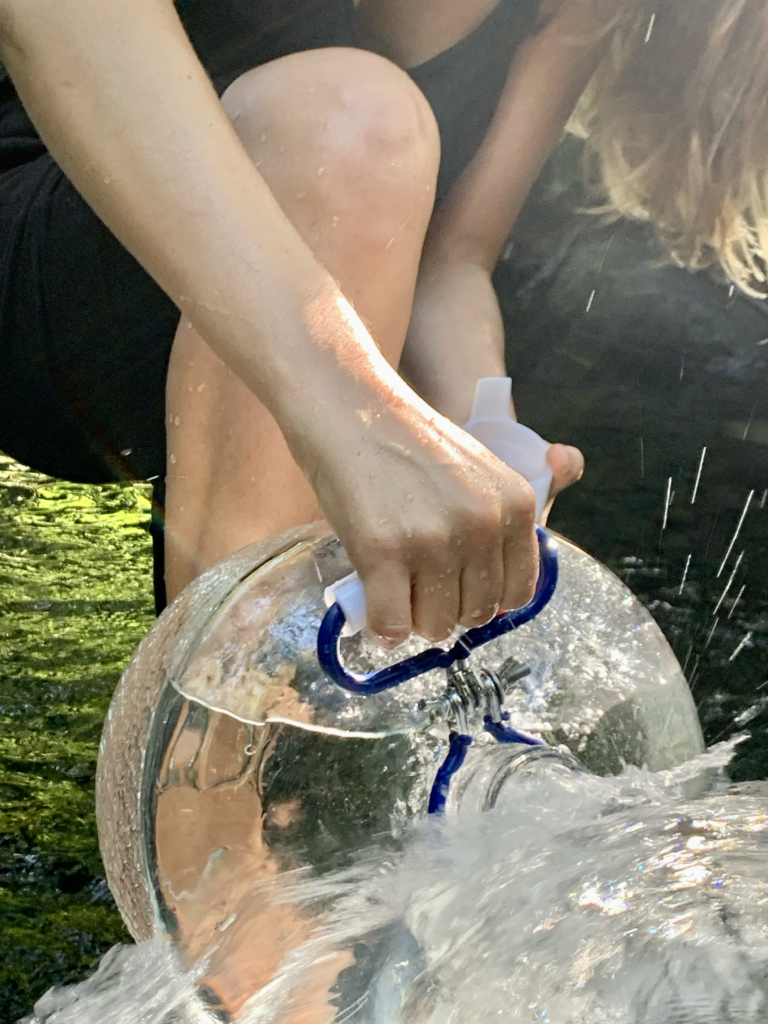Less than an hour’s drive from Estacada, Oregon lies historic Bagby Hot Springs – Oregon’s most popular hot springs. Surrounded by the lush Mount Hood National Forest, sun dapples in through old growth trees along the 1.5-mile hike (stroll) to reach Bagby Hot springs’ three soaking options.
Bagby Hot Springs Soaking Pools
The first soaking option is located on the Private Deck which houses five hollowed-out logs, each enclosed within a private room. The Private Deck is partially covered to allow sky views and keep your belongings dry. Please note the Private Deck is closed during a restoration project until Summer 2019.
The second option is the Public Deck, featuring three hollowed-out log tubs salvaged from the 1979 fire and one whiskey barrel style tub.
A short distance from the Public Deck lies the third option – the Upper Deck, which was constructed by the Friends of Bagby. This large deck is home to another whiskey barrel soaking tub, which holds around eight people (or so). At Bagby Hot Springs, the Public and Upper Decks are shared, communal soaks.
Fees at Bagby Hot Springs
Soaking Fee: $5.00/person – Bagby wristbands can be purchased on-site with cash or with a credit card at the Ripplebrook Guard Station. No parking or day use fee, just to soak.
Alcohol Ban
In 2002 the Forest Service banned alcohol at the hot springs, please be respectful of this rule, and remember to always pack out what you pack in!
Bagby Hot Springs Camping
Car camping is available at the Bagby Hot Springs trailhead and a mere quarter mile beyond the hot springs at Shower Creek Campground for backpackers. No camping is allowed along the trail or at the hot springs.
Season
The campground is closed after Labor Day until May or April depending on weather conditions.
Camping Fees
Single sites are available for $15/night and double occupancy sites for $24/night.
Nearby attractions include Shower Creek Falls and Silver King Lake (6 miles from Shower Creek CG).
Bagby History Lesson
Hunter and prospector, Bob Bagby, discovered the hot springs back in 1880. Not much is known about what happened between then and 1913 when Phil Putz of the Forest Service Guard built a cabin that is still present today. In the 1920s, facilities were expanded to house a small fire crew and in 1974 a new guard cabin was erected.
Over the course of many years, a volunteer group known as The Friends of Bagby designed and constructed the current bathing facilities at Bagby. Upkeep was maintained by the Forest Service until the management of Babgy was turned-over to a private organization that presently manages the hot springs. Learn more on the Forest Service website.
Winter Hot Springing Warning
The Forest Service does not maintain the roads and trails into and around Bagby during the winter season and strongly discourages attempting to reach the hot springs if there is snow on the ground. Every year multiple soak seekers end up getting stuck and having to contact the Sherrif for assistance.
Since there is no area cell phone coverage, visitors considering a visit to Bagby during the winter season are encouraged to either call or stop by the Ripplebrook Guard Station before attempting to reach the trailhead.
Driving Directions
- From Estacada, drive 26 miles up the Clackamas River Basin South East on Highway 224.
- Turn South on FSR 46 just past Ripplebrook Guard Station.
- Continue on FSR 46 for 4 miles along the Collawash River until you reach a junction with FSR 63.
- Follow FSR 63 South for 4 miles to a junction with FSR 70.
- Take FSR 70 South West for 6 miles to the parking area and trailhead for Bagby Hot Springs. The campground is to the left and Bagby Hot Springs Trailhead on the right upon entering the parking area. There is also an outhouse, trash bin and information booth on-site.
Conservation Efforts
As one of Oregon’s most popular hot springs destinations, Bagby sees a lot of use. Please pack out all of your belongings and all trash encountered. This special place needs all the help it can get. The Forest Service has a resource for outdoor safety and ethics that all hot springers should be well acquainted with. Bathing with soap or shampoo including biodegradable soap or shampoo is not only frowned upon, but is also illegal. Don’t be THAT person.
Bagby Hot Springs Soak Stats:
Season: Spring, Summer, Fall (access road often closed during winter)
Type: Hike (1.4 miles Bagby Hot Springs Trail #544)
GPS: 44.936 122.173
Map Quad: BATTLE AX 15 (or Mount Hood National Forest Map)
Elevation: 2,250 ft
Land: Public – Official Page (Picnic Site)
Fee: Yes – $5/person (wristbands for soaking can be purchased on-site with cash or with a credit card at the Ripplebrook Guard Station)
Restrictions: Day use fee, no camping at springs or along trail
Usage: High
Visibility: Low
Temp: 102-105
Water Clarity: Semi-Clear
Odor: n/a
pH: n/a
Area Features: Shower Creek Falls, Silver King Lake
Closest Food/Gas: Estacada
Trash: High
Bugs: Moderate
Wildlife: Moderate
Camping: Paid at trailhead/parking area, backpack camping past hot springs, other nearby NF campgrounds
Clothing Optional: Only in private bathhouse
Pit Toilet: Yes







Responses